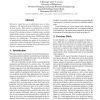Free Online Productivity Tools
i2Speak
i2Symbol
i2OCR
iTex2Img
iWeb2Print
iWeb2Shot
i2Type
iPdf2Split
iPdf2Merge
i2Bopomofo
i2Arabic
i2Style
i2Image
i2PDF
iLatex2Rtf
Sci2ools
FGR
2004
IEEE
2004
IEEE
A Model of Facial Behaviour
We wish to model the way in which faces move in video sequences. We represent facial behaviour as a sequence of short actions. Each action is a sample from a statistical model representing the variability in the way it is performed. The ordering of actions is defined using a variable length Markov model. Action models and variable length Markov model are trained from a long (20000 frames) video sequence of a talking face. We propose a novel method of quantitatively evaluating the quality of the synthesis by measuring overlaps of parameter histograms. We apply this method to compare our technique with an alternative model that uses an autoregressive process.
| Added | 20 Aug 2010 |
| Updated | 20 Aug 2010 |
| Type | Conference |
| Year | 2004 |
| Where | FGR |
| Authors | Franck Bettinger, Timothy F. Cootes |
Comments (0)

